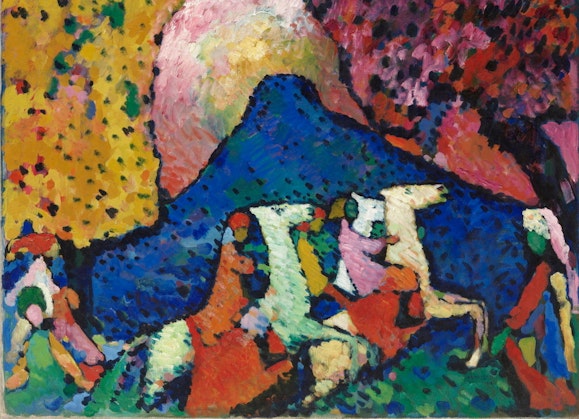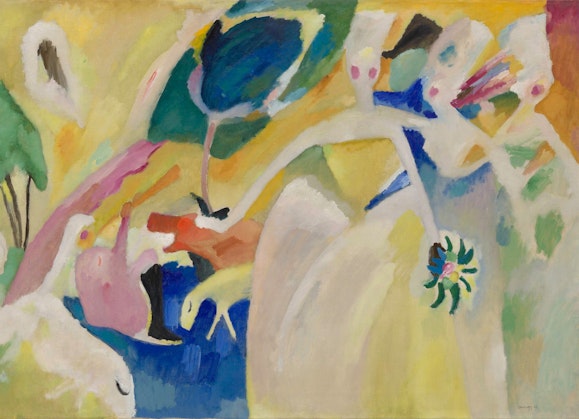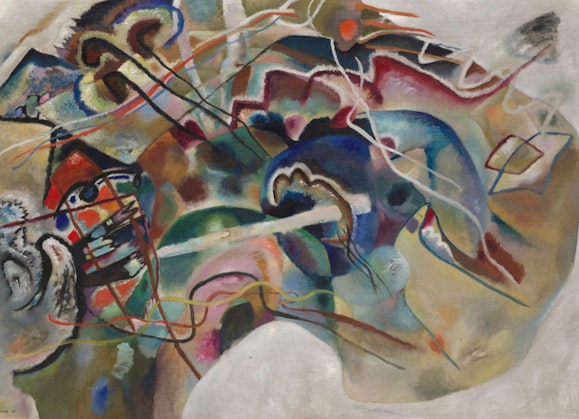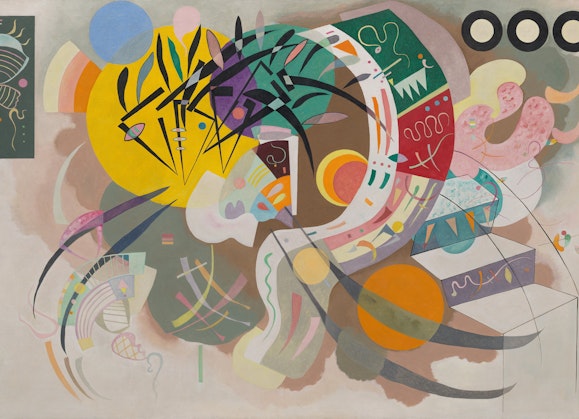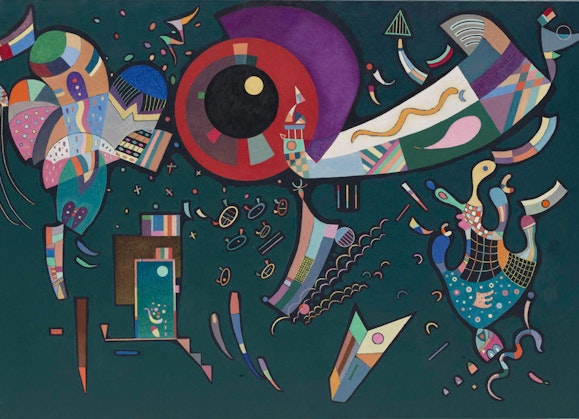Kandinsky
Open your ears to music, your eyes to painting. And don’t think! Examine yourselves … when you have heard and seen. Ask yourselves, if you like, whether the work of art has carried you away to a world unknown to you before. If so, what more do you want?
This learning resource is designed to engage primary and secondary students with the exhibition Kandinsky and inspire art-making, critical thinking and discussion about the art and life of one of the great innovators of European abstraction. Like the exhibition, this resource traces Kandinsky’s aesthetic evolution. It is divided into six periods within Kandinsky’s life, each accompanied by artworks and educational prompts for learning about the ideas that inspired him.
Use this resource in the classroom or in conjunction with a visit to the exhibition Kandinsky at the Art Gallery of New South Wales, curated with the Solomon R. Guggenheim Museum in New York.
-
In this resource
In this resource you will find images of key artworks, exhibition wall labels along with artist quotes, curator audio and curriculum-based strategies for making and responding.
Exhibition sections
Beginnings: Kandinsky’s early career in Munich at the start of the 20th century
Towards abstraction: the artist’s first experiments with abstraction
A new reality: Kandinsky’s return to Moscow with the outbreak of the First World War
Cosmic realms: the interwar years in Germany as a teacher at the Bauhaus art school
A circular journey: the Paris years with a new palette and an interest in biomorphism
Final years: Kandinsky’s final years and a return to early ideas and subjects
K–6 questions and activities encourage students to identify, discuss and experiment with different techniques, media and variations of form and colour to gain an understanding of abstraction and Kandinsky’s art. These making and responding ideas help students to connect the artworks to their own world.
7–12 questions and activities are designed to support student analysis of Kandinsky’s artworks using the frames and conceptual framework. These prompts encourage critical thinking about the artist’s practice and the relationships between the artist, artworks, audiences and the world in which they were created.
-
Who is Kandinsky?
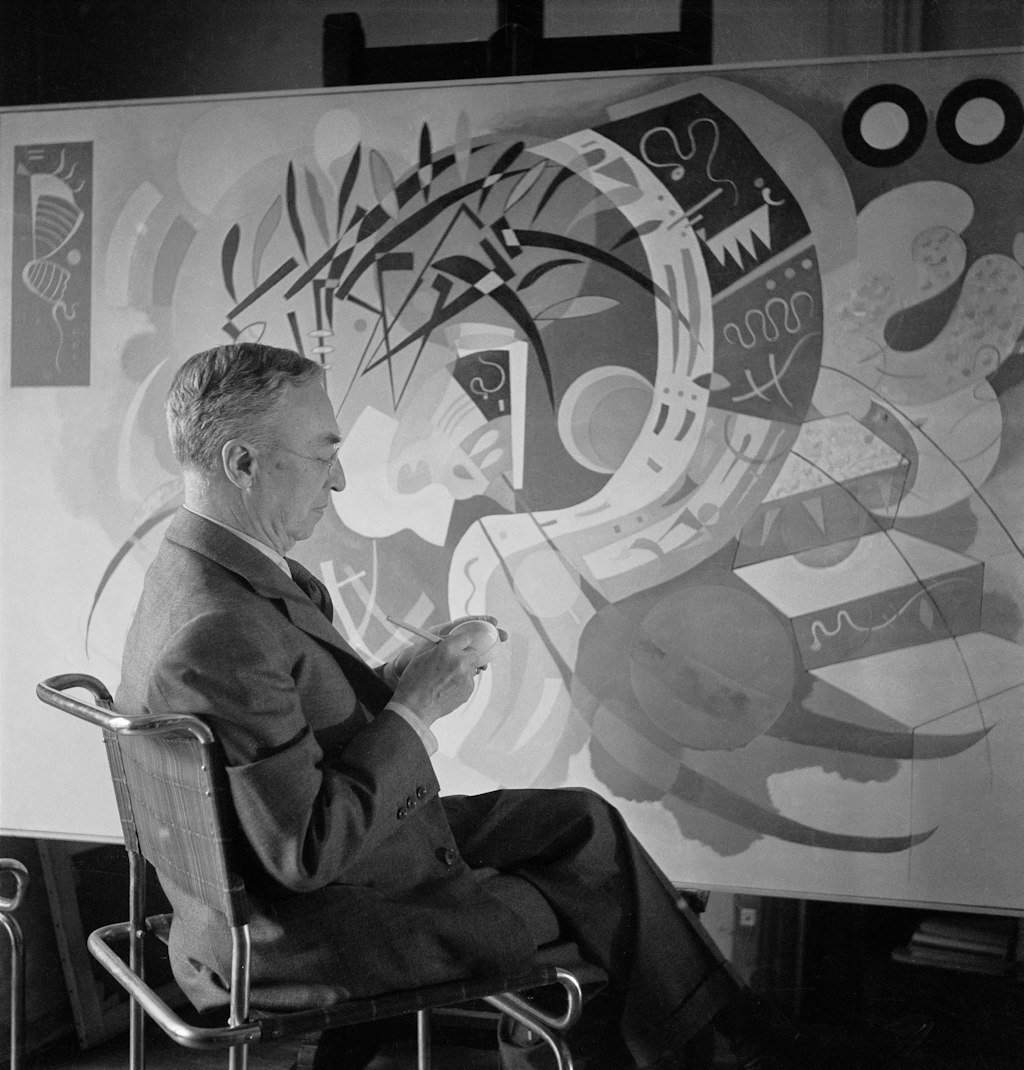
Vasily Kandinsky in front of his painting Dominant curve 1936, 1936, photo: Bibliothèque Kandinsky, Centre Pompidou, Paris, © Lipnitzki/Roger Violett/Getty Images
Born in Moscow to a wealthy family, Vasily Kandinsky (Wassily Kandinsky, 1866–1944) spent his early childhood in Odessa, Russia (now Odesa, Ukraine). His parents instilled in him an early love of music that later influenced his work. Though he studied law and economics at the University of Moscow and his life seemed destined to follow a conventional path, at age 30 he abruptly decided to abandon his legal career and devote himself to art.
His decision was prompted by two important experiences. In 1896, he attended an impressionist exhibition, where he saw a Haystack painting by the French artist Claude Monet (1840–1926). Stirred by the encounter, Kandinsky later realised that the painting’s colour and composition, not its subject matter, caused his response. That same year, he attended a performance of the opera Lohengrin by Richard Wagner (1813–83) and noticed that music could elicit an emotional response without a connection to a recognisable subject. This experience led him to believe that painting should aspire to be as abstract as music.
In 1896, Kandinsky left Russia for Munich in Germany, where he studied art and began to pursue his new career. In 1908, while in his early 40s, he began developing a range of artistic tools, gradually stripping away recognisable imagery from his work. Kandinsky participated in several of the 20th century’s most influential and controversial art movements, among them the Blue Rider (Der Blaue Reiter), a loose affiliation of artists he founded in 1911 with German artist Franz Marc (1880–1916). As Kandinsky stated: ‘We thought up the name while sitting at a cafe table … Both of us were fond of blue things, Marc of blue horses and I of blue riders. So the title suggested itself.’ In 1912, Kandinsky published his book On the spiritual in art – one of the first modern theoretical treatises on abstraction. It examined the capacity of colour to communicate the artist’s innermost psychological and spiritual concerns.
Kandinsky’s life was strongly affected by the wars and politics that raged in Europe during the early 20th century. With the outbreak of the First World War in 1914, Kandinsky left Germany and moved back to Moscow. He remained in Russia throughout the Russian Revolution of 1917 and in 1921 returned to Germany. In 1929 he became a German citizen – one of three nationalities he held during his life, along with Russian and French – but the Nazis’ rise to power and their closure in 1933 of the Bauhaus art school, where he taught, forced him to move to France. Despite the war and German occupation of France, his works were shown in small exhibitions. In 1939, he became a French citizen and died in Neuilly-sur-Seine outside Paris in 1944. His reputation had been firmly established in the United States through numerous shows and his introduction to American collectors, including Solomon R. Guggenheim, who became one of his most enthusiastic supporters.
This biography is drawn from the Solomon R. Guggenheim Museum’s teaching materials on Kandinsky.
-
What is abstraction?
In the first decades of the 20th century, a radical approach to art emerged almost simultaneously across Europe and in the United States: abstraction.
Abstraction, with its long history in diverse world cultures, was never a ‘movement’. In European modernism, it didn’t originate in one place, and it wasn’t practised by one cohesive group of artists. Instead, it evolved gradually, as artists experimented with colour, form and materials, calling into question some of the traditional functions of art, such as narrative and representation. The final decades of the 1800s saw a proliferation of artworks in which the figure or the landscape was – in increasing degrees – abstracted, distorted or simplified.
The paths to abstraction were varied and unpredictable. In 1867, the London-based artist James McNeill Whistler began emphasising the ‘musical’ qualities of painting. In 1890, in Paris, Maurice Denis declared that ‘a picture is essentially a plane surface covered with colours assembled in a certain order’. One of first theoretical treatises on abstraction, On the spiritual in art, was written by Kandinsky in 1912, and by 1917, many artists had abandoned representation altogether.
Think about the term ‘abstract’ and its use in art. What is the difference between abstracted art and abstract art or abstraction? How does the way we use the term in art compare to how we use it in everyday language?
-
Artist’s writings
In addition to making art, Kandinsky produced several texts including poetry and writings on art.
The ‘musical album’ Sounds is a collection of tone poems and abstract woodcuts that furthered Kandinsky’s fundamental idea of ‘synthesis’ – the unification of all the arts. For Kandinsky, the word ‘sound’ was interchangeable with the notions ‘inner resonance’ or ‘spiritual vibration’.
The blue rider almanac was part of Kandinsky and fellow artist Franz Marc’s search for the spiritual in art and the dissolution of its categories. As they wrote, ‘art, knows no borders or nations, only humanity’. Reproductions by modern artists were shown alongside images of medieval woodcuts, bronzes from Benin, children’s drawings and musical scores, reflecting the imperialist and colonialist attitudes of the era while aiming for cultural exchange.
On the spiritual in art, one of the most influential texts in the history of modern art, establishes the philosophical basis of Kandinsky’s abstract painting. It explores the special relationship of colour to feeling, revealing his great debt to theosophy, a spiritual movement founded in the late 19th century. His use of the word ‘spirit’ is complex, with the German word geist ranging from the mystical to intellectual consciousness.
Kandinsky developed this text Point and line to plane in 1926 while teaching at the Bauhaus art school. It was released in English in 1947 for the Museum of Non-Objective Painting – the original name of the Solomon R. Guggenheim Museum in New York. In it, Kandinsky formulates a language of abstract art, analysing line and form and asking the novel question ‘what are art’s basic elements?’
Additional resources
Related artworks and exhibitions
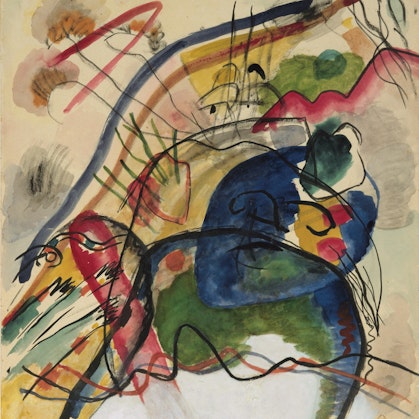
Learning workshop: Alchemy and abstraction
By Desmond Lazaro for primary and secondary students
Book now
